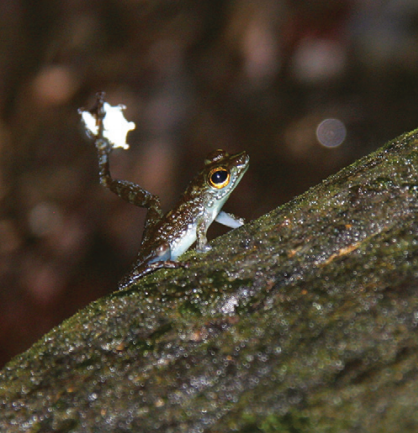Genome Sequencing of the Bornean Rock Frog

Project Information
big-data, genomics, bioinformaticsProject Status: Complete
Project Region: Northeast
Submitted By: Lisa Mangiamele
Project Email: lmangiamele@smith.edu
Project Institution: Smith College
Anchor Institution: NE-MGHPCC
Project Address: 44 College Lane
Northampton, Massachusetts. 01063
Mentors: Riccardo Racicot, Rob Harbert
Students: yaniv kovalski
Project Description
We are working to sequence the genome of the Bornean Rock Frog, Staurois parvus. This frog uses a novel communication signal called "foot flagging", where it waves its back feet to send messages to other frogs. We currently have 220+GB of PacBio Sequel II genome sequence from an adult male frog. To make this genome a usable, accessible tool this sequence needs to be assembled, polished and annotated. This tool will help us investigate the evolution of new behaviors and how hormones regulate the nervous system.Students working on this project will have the opportunity to work in the exciting field of amphibian genomics. Amphibians are notorious for having large complex genomes that are difficult to sequence and assemble. Due to this, students will have a very in-depth experience troubleshooting many steps of the sequencing and assembly pipeline. To date there have only been 10 frog genomes published, so students will have experience in a emerging field.

Project Information
big-data, genomics, bioinformaticsProject Status: Complete
Project Region: Northeast
Submitted By: Lisa Mangiamele
Project Email: lmangiamele@smith.edu
Project Institution: Smith College
Anchor Institution: NE-MGHPCC
Project Address: 44 College Lane
Northampton, Massachusetts. 01063
Mentors: Riccardo Racicot, Rob Harbert
Students: yaniv kovalski
Project Description
We are working to sequence the genome of the Bornean Rock Frog, Staurois parvus. This frog uses a novel communication signal called "foot flagging", where it waves its back feet to send messages to other frogs. We currently have 220+GB of PacBio Sequel II genome sequence from an adult male frog. To make this genome a usable, accessible tool this sequence needs to be assembled, polished and annotated. This tool will help us investigate the evolution of new behaviors and how hormones regulate the nervous system.Students working on this project will have the opportunity to work in the exciting field of amphibian genomics. Amphibians are notorious for having large complex genomes that are difficult to sequence and assemble. Due to this, students will have a very in-depth experience troubleshooting many steps of the sequencing and assembly pipeline. To date there have only been 10 frog genomes published, so students will have experience in a emerging field.